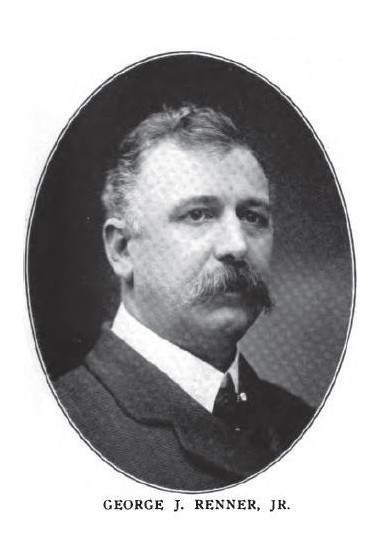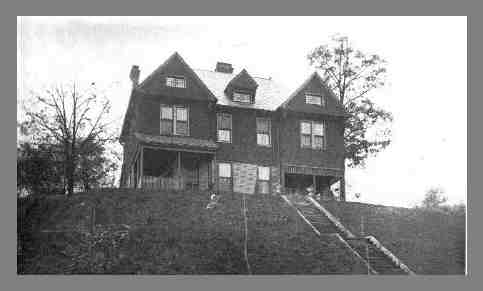

The Renner family sold the mansion in 1939, four years after the death of George J. Renner, Jr. in December of 1935. George J. Renner, Jr's son Emil A. Renner had a residence at 835 Michigan Ave, next to the Renner Mansion. After Emil sold this residence it was converted to apartments and has since been torn down. Emil A. Renner died in 1976.
At some point the mansion was purchased by Youngstown State University and used as the University President's house and later sold to private owner(s). The mansion was last sold in 1984 for a price of $35,000. Daniel Reese, who owns several properties on the North Side of Youngstown, is listed as the current owner.
The Renner Mansion has been split up into 12 apartments, many of the original fixtures have been removed. There used to be a large, stained glass mural over the staircase landing/mezzanine and stained glass (called "art glass" in the old days) in other places throughout the home. The floor of the front porch and main staircase landing (mezzanine)still have old fashioned bisque (very small ceramic)tiles on them. Most likely, there is still some of the original tile "wainscoating" remaining in what were the original bathrooms, pantries and kitchen.
The interior walls in the Renner Mansion are 18 inches thick because most of the rooms had "pocket" doors, ie: doors that slide out of a hollow between the two sides of each wall to close off a room. Pocket doors were a very common architectural feature of the homes of this era. Some of the pocket doors remain, in the second floor hallway there is a very wide, single pocket door which appears to have been fixed in place so that it will not open. This is most likely the libary that has been described in newspaper articles about the mansion.
On the ground floor by the side (Portico) entrance there are double pocket doors still remaining on either side of the hallway, also fixed in place so that they no longer open.
When the mansion was converted to apartments, most of the old pocket doors were slid into their pockets inside the walls, and the doorways were fitted with conventional, hinged doors with locks on them to form the individual apartments. The mansion also has double floors, according to a 1907 newspaper article.
Interesting to note that the original announcement made in the Society pages of the Vindicator (see article below) says that the front porch roof and side portico roof were to be supported by stone pillars, however the mansion actually has wooden pillars supporting both of these roofs. The article also says that the hall floors were to be made of marble, but when the mansion was built, oak floors were used. The main staircase IS made of marble, however.
The coach house has been split up into three apartments, also and a garage has been added onto the north side of the coach house.
The article below says that George J. Renner was to spend $40,000 to build the mansion, however other articles that appeared in the newspapers have stated that he spent over $75,000 by the time the mansion was completed in 1907.
HANDSOME Dwelling to be erected by Geog. J. Renner, Jr. at heavy cost.
Plans have been prepared and bids will be received after January
first.
George J. Renner, the wealthy Youngston brewer, has the plans about completed for one of the finest residences in this city. The house, with the barn which is to be built later, will represent an outlay of $40,000, and will be built on the North Side, the site not as yet having been decided upon. A.F. Judd is the architect.
The style of the house will be colonial, of the purest Georgian type. Besides the halls, bath rooms and pantries, it will contain 14 main rooms. The front will be graced by a large porch, the entire width of the house, and supported by stone columns. The facing of the building will be pressed brick trimmed with Vermont granite. The roofing will be of the best Spanish tile, and the glass used will be both art and plate.
The interior trimmings will be of mohagony and quartered oak. The floors will be of tile and hardwood. The vacuum system of steam heating will be installed with instantaneous water heating process. The wide hall, characteristic of the old colanial pattern, will have a marble floor and panel wainscoting and beam ceilings will grace both it and the den. Nine mantles, representing the various styles of the times, will be installed.
The house will be piped and wired for the use of both gas and electric lights. The kitchen and bathrooms will be wainscoated with old English tile. The cellar will be divideded into apartments, after the style of old mansions.
All through the building there will be speaking tubes and annunciators, so that communication to all its parts will be easy. The exterior will be set off by a large portecochere, supported like the porch by stone columns. In the attic will be a large hall, and the servant's quarters, besides a room for storage.
The architect in speaking of the house as planned stated that there are more costly residences in Youngstown, but there will be none which will show up to better advantage on the outside. Besides this, the interior will be planned to provide every taste of the owner, who has decided upon the style of a home he desires after great deliberation. The contract will be let in the spring, and figures will be acceptable after February 1.
BIOGRAPHICAL INFO
George J. Renner, Jr. was born in Cincinatti, Ohio on February 11, 1856. He ws the son of George J. Renner, Sr. and Seraphina (Appleman) Renner. George J. Renner had 11 siblings: Lizzie, Rosa, Nora, Emma, William are some of them.
George J. Renner, Jr. grew up in Covington, KY. His first brewery was located in Wooster, Oh. and he moved to Youngstown in 1884. In 1880 he married Emma Weaver of Covington, KY and they had eight children: George III, Emil A, Edna, Irene, Viola, Florence, Ruth and Earl. The family home was located at 209 Pike Street before he lived at the Renner Mansion on Park Avenue.
